Middleton W.M. (ed.) Reference Data for Engineers: Radio, Electronics, Computer and Communications
Подождите немного. Документ загружается.

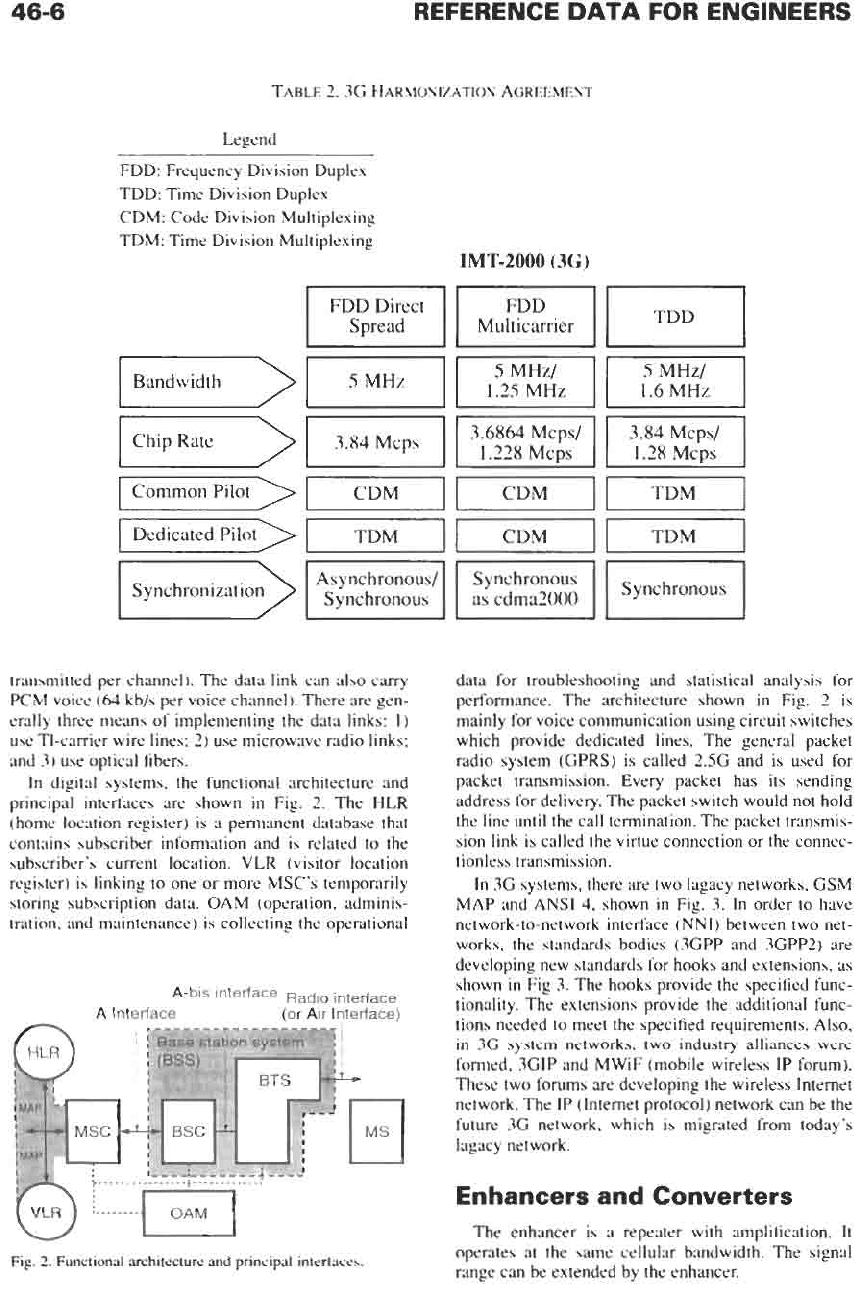
46-6
REFERENCE
DATA
FOR
ENGINEERS
TABLE
2.3G HARMONIZATION AGREEMENT
Legend
FDD: Frequency Division Duplex
TDD: Time Division Duplex
CDM: Code Division Multiplexing
TDM: Time Division Multiplexing
IMT-2000
(3G)
Spread Multican-ier
1.25
MHz
1.6
MHz
Common
Pilot
Dedicated Pilot
transmitted per channel). The data link can also carry
PCM voice
(64
kb/s per voice channel). There
are
gen-
erally three means of implementing the data links:
1)
use TI-carrier wire lines;
2)
use microwave radio links;
and
3)
use optical
fibers.
In digital systems, the functional architecture and
principal interfaces
are
shown in Fig.
2.
The
HLR
(home location register) is a permanent database that
contains subscriber information and is related to the
subscriber’s current location. VLR (visitor location
register) is linking to one
or
more MSC’s temporarily
storing subscription data. OAM (operation, adminis-
tration, and maintenance) is collecting the operational
A-bis interface Radio
interface
A
Interface
(or
Air Interface)
Fig.
2.
Functional
archirectum
and
principal interfaces.
data for troubleshooting and statistical analysis for
performance. The architecture shown in Fig.
2
is
mainly for voice communication using circuit switches
which provide dedicated lines. The general packet
radio system (GPRS) is called 2.5G and is used for
packet transmission. Every packet has its sending
address for delivery. The packet switch would not hold
the line until the call termination. The packet transmis-
sion link is called the virtue connection
or
the connec-
tionless transmission.
In
3G systems, there
are
two lagacy networks, GSM
MAP and ANSI
4,
shown in Fig. 3. In order to have
network-to-network interface (NNI) between two net-
works, the standards bodies (3GPP and 3GPP2)
are
developing new standards for hooks and extensions, as
shown in Fig 3. The hooks provide the specified func-
tionality. The extensions provide the additional func-
tions needed to meet the specified requirements. Also,
in 3G system networks, two industry alliances were
formed, 3GIP and MWiF (mobile wireless
IP
forum).
These two forums
are
developing the wireless Internet
network. The
P
(Internet protocol) network can
be
the
future 3G network, which is migrated from today’s
lagacy network.
Enhancers and Converters
The enhancer is a repeater with amplification. It
operates at the same cellular bandwidth. The signal
range can be extended by the enhancer.
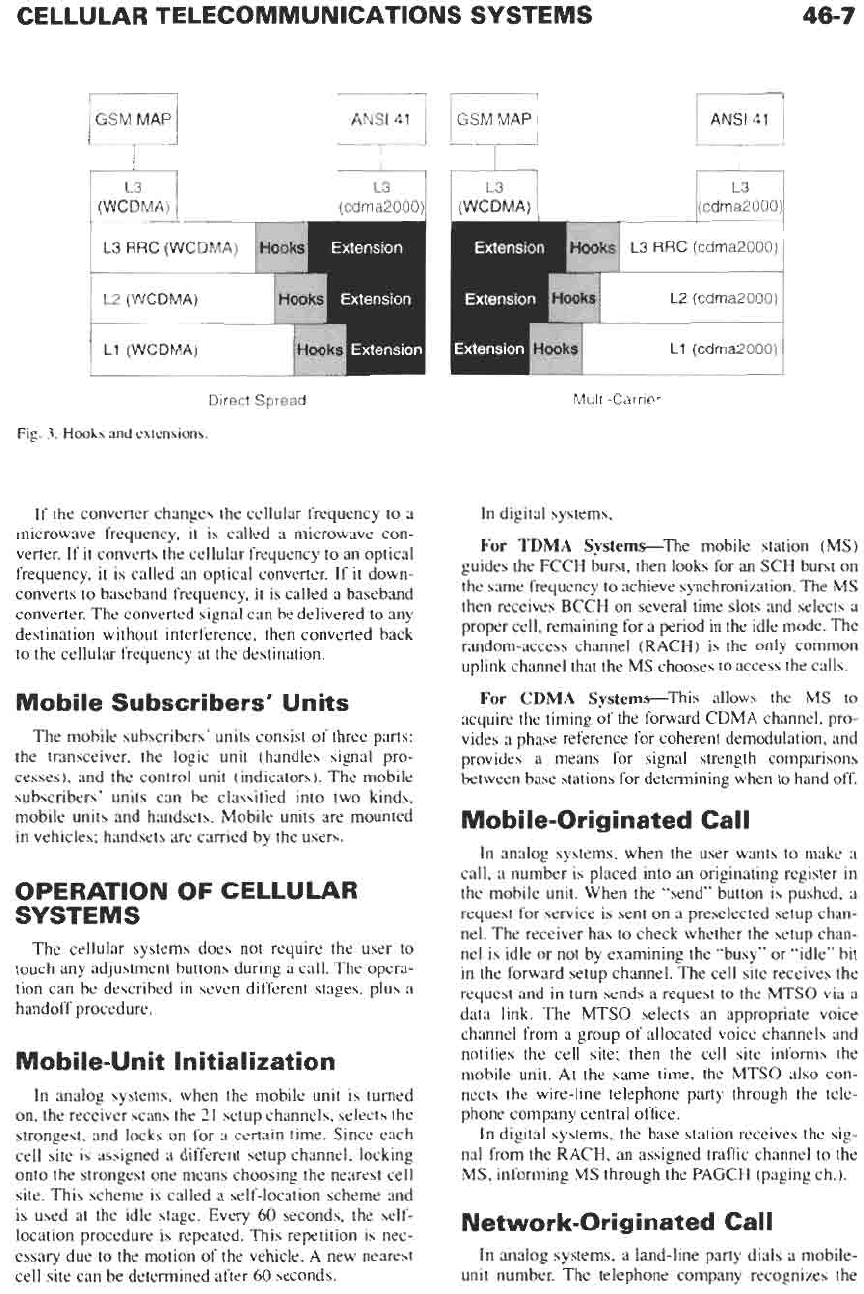
CELLULAR TELECOMMUNICATIONS SYSTEMS
I
L1
(WCDMA)
1
Hook
ANSI
41
(cdrna2000)
Direct Spread
Fig.
3.
Hooks
and
extensions.
If the converter changes
the
cellular frequency to a
microwave frequency, it is called a microwave con-
verter. If it converts the cellular frequency to an optical
frequency, it is called an optical converter. If it down-
converts to baseband frequency, it is called a baseband
converter. The converted signal can
be
delivered to any
destination without interference, then converted back
to the cellular frequency at the destination.
Mobile Subscribers’ Units
The mobile subscribers’ units consist of three parts:
the transceiver, the logic unit (handles signal pro-
cesses), and the control unit (indicators). The mobile
subscribers’ units can be classified into two kinds,
mobile units and handsets. Mobile units
are
mounted
in vehicles; handsets are carried by the users.
OPERATION
OF
CELLULAR
SYSTEMS
The cellular systems does not require the user to
touch any adjustment buttons during a call. The
opera-
tion can be described in seven different stages, plus a
handoff procedure.
Mobile-Unit Initialization
In analog systems, when the mobile unit is turned
on, the receiver scans the
21
setup channels, selects the
strongest, and
locks
on for a certain time. Since each
cell site is assigned a different setup channel, locking
onto
the
strongest one means choosing the nearest cell
site. This scheme is called a self-location scheme and
is used at the idle stage. Every
60
seconds, the self-
location procedure is repeated. This repetition is nec-
essary due to the motion of the vehicle. A new nearest
cell site can
be
determined after
60
seconds.
rl
ANSI
41
Fl
(WCDMA)
L3
l(cdma2000~
1
Hooks1
L3
RRC (cdrna2000)
I
L2
(cdrna2000)
L1
(cdrna2000)
Multi-Carrier
46-7
In digital systems,
For
TDMA
SystemsThe mobile station
(MS)
guides the FCCH burst, then looks
for
an SCH burst on
the same frequency to achieve synchronization. The
MS
then receives BCCH on several time slots and selects a
proper
cell, remaining for a
period
in the idle mode. The
random-access channel (RACH) is
the
only common
uplink channel that
the
MS chooses to access the calls.
For
CDMA
Systems-This allows
the
MS
to
acquire
the
timing of the forward CDMA channel,
pro-
vides a phase reference for coherent demodulation, and
provides a means for signal strength comparisons
between base stations for determining when to hand off.
Mobile-Originated Call
In
analog systems, when the user wants to make a
call, a number is placed into an originating register in
the mobile unit. When the “send” button is pushed, a
request
for
service is sent on a preselected setup chan-
nel. The receiver has to check whether the setup chan-
nel is idle
or
not by examining the “busy” or “idle” bit
in the forward setup channel. The cell site receives the
request and in turn sends a request to the
MTSO
via a
data link. The
MTSO
selects an appropriate voice
channel from a group of allocated voice channels and
notifies the cell site; then the cell site informs the
mobile unit. At the same time, the
MTSO
also con-
nects the wire-line telephone party through the tele-
phone company central office.
In digital systems, the base station receives the sig-
nal from the RACH, an assigned traffic channel to the
MS, informing
MS
through the PAGCH (paging ch.).
Network-Originated Call
In analog systems, a land-line party dials a mobile-
unit number. The telephone company recognizes the
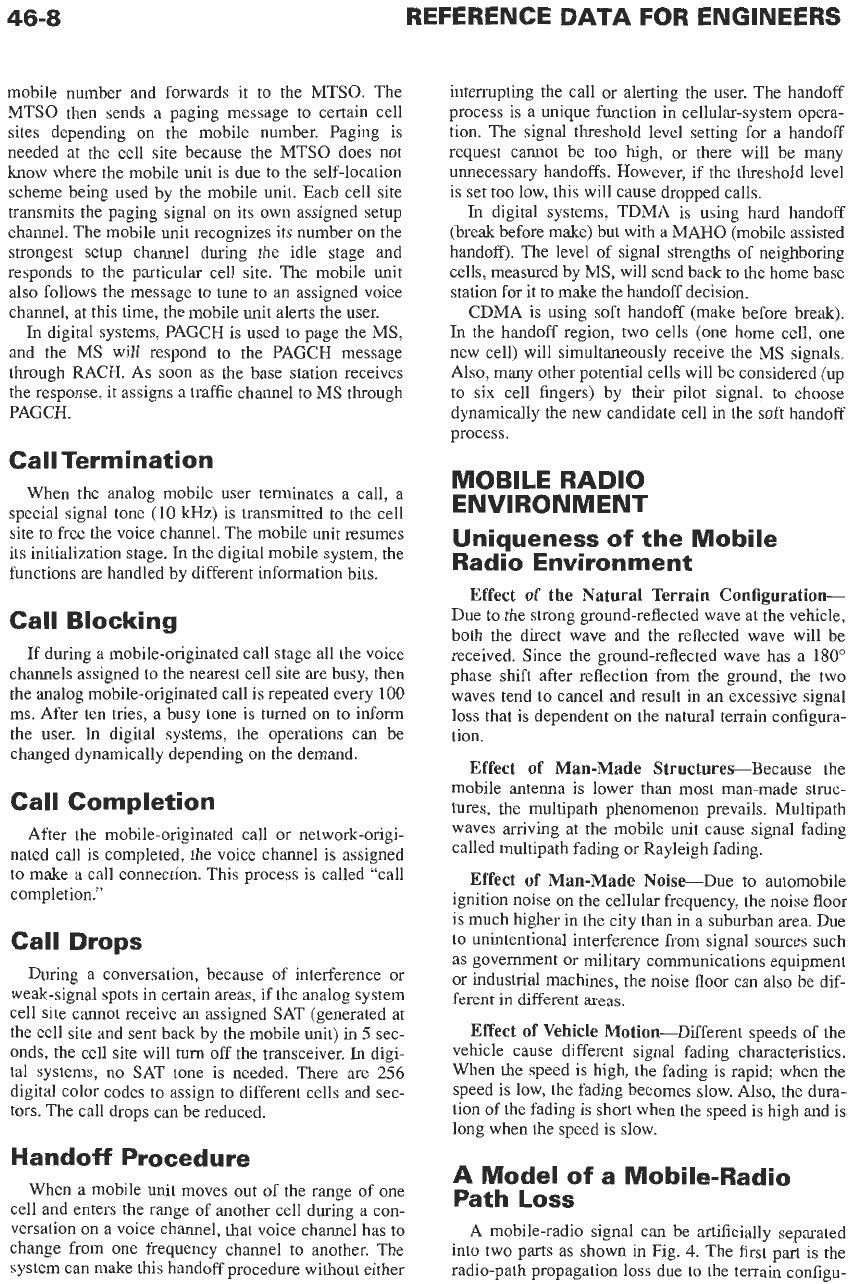
mobile number and forwards it to the MTSO. The
MTSO then sends a paging message to certain cell
sites depending on the mobile number. Paging is
needed at the cell site because the MTSO does not
know where the mobile unit is due to the self-location
scheme being used by the mobile unit. Each cell site
transmits the paging signal on its own assigned setup
channel. The mobile unit recognizes its number on the
strongest setup channel during the idle stage and
responds to the particular cell site. The mobile unit
also follows the message to tune to an assigned voice
channel, at this time, the mobile unit alerts the user.
In
digital systems, PAGCH is used
to
page the
MS,
and the MS will respond to the PAGCH message
through RACH. As soon as the base station receives
the response, it assigns a traffic channel to MS through
PAGCH.
Ca
I
I
Termination
When the analog mobile user terminates a call, a
special signal tone
(10
kHz)
is transmitted to the cell
site to free the voice channel. The mobile unit resumes
its initialization stage.
In
the digital mobile system, the
functions are handled by different information bits.
Call Blocking
If during a mobile-originated call stage all the voice
channels assigned to the nearest cell site are busy, then
the analog mobile-originated call is repeated every
100
ms. After ten tries, a busy tone is turned on to inform
the user. In digital systems, the operations can be
changed dynamically depending on the demand.
Call Completion
After the mobile-originated call or network-origi-
nated call is completed, the voice channel is assigned
to make a call connection. This process is called “call
completion.”
Call Drops
During a conversation, because of interference or
weak-signal spots in certain areas, if the analog system
cell site cannot receive an assigned SAT (generated at
the cell site and sent back by the mobile unit) in
5
sec-
onds, the cell site will
turn
off the transceiver. In digi-
tal systems, no SAT tone is needed. There
are
256
digital color codes to assign
to
different cells and sec-
tors. The call drops can be reduced.
Handoff Procedure
When a mobile unit moves out of the range of one
cell and enters the range of another cell during a con-
versation on a voice channel, that voice channel has to
change from one frequency channel to another. The
system can make this handoff procedure without either
interrupting the call or alerting the user. The handoff
process is a unique function in cellular-system opera-
tion. The signal threshold level setting for a handoff
request cannot be too high, or there will be many
unnecessary handoffs. However, if the threshold level
is set too low, this will cause dropped calls.
In
digital systems, TDMA is using hard handoff
(break before make) but with a
MAHO
(mobile assisted
handoff). The level
of
signal strengths of neighboring
cells, measured by MS, will send back to the home base
station for it
to
make the handoff decision.
CDMA is using soft handoff (make before break).
In
the handoff region, two cells (one home cell, one
new cell) will simultaneously receive the
MS
signals.
Also, many other potential cells will be considered (up
to six cell fingers) by their pilot signal, to choose
dynamically the new candidate cell in the soft handoff
process.
MOBILE RADIO
ENVIRONMENT
Uniqueness
of
the Mobile
Rad io Environment
Effect
of
the Natural Terrain Configuration-
Due to the strong ground-reflected wave at the vehicle,
both the direct wave and the reflected wave will be
received. Since the ground-reflected wave has a
180”
phase shift after reflection from the ground, the two
waves tend to cancel and result in an excessive signal
loss that is dependent on the natural terrain configura-
tion.
Effect of Man-Made StructuresBecause the
mobile antenna is lower than most man-made struc-
tures, the multipath phenomenon prevails. Multipath
waves arriving at the mobile unit cause signal fading
called multipath fading or Rayleigh fading.
Effect of Man-Made Noise-Due to automobile
ignition noise on the cellular frequency, the noise floor
is much higher in the city than in a suburban area. Due
to unintentional interference from signal sources such
as government or military communications equipment
or industrial machines, the noise floor can also be dif-
ferent
in
different areas.
Effect of Vehicle Motion-Different speeds
of
the
vehicle cause different signal fading characteristics.
When the speed is high, the fading is rapid when the
speed is low, the fading becomes slow.
Also,
the dura-
tion of the fading is short when the speed is high and is
long when the speed is slow.
A Model
of
a Mobile-Radio
Path Loss
A mobile-radio signal can be artificially separated
into two parts as shown in Fig.
4.
The first part is the
radio-path propagation loss due to the terrain configu-
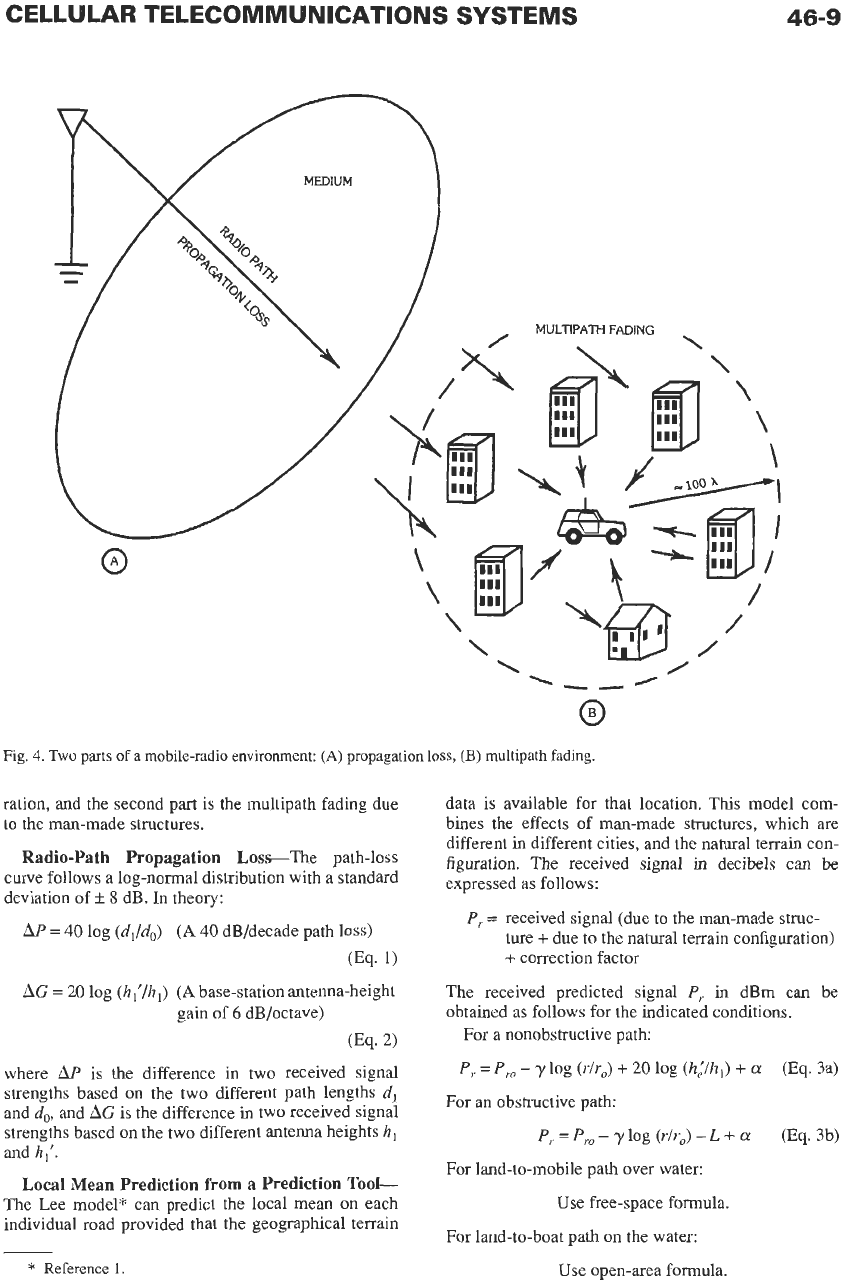
CELLULAR TELECOMMUNICATIONS SYSTEMS
46-9
MULTIPATH
FADING
\
\.
\
\
J#
#/
I
II
.
Fig.
4.
Two
parts
of
a mobile-radio environment:
(A)
propagation
loss,
(B)
multipath fading.
ration, and the second part is the multipath fading due
to the man-made structures.
data is available for that location.
This
model com-
bines the effects
of
man-made structures. which are
different
in
different cities, and the natural terrain con-
expressed
as follows~
Radio-Path Propagation
LOssThe
path-1oss
figmation. The received signal in decibels can
&
curve follows a log-normal distribution with a standard
deviation of
&
8
dB. In theory:
P,
=
received signal (due to the man-made struc-
ture
+
due
to
the natural terrain configuration)
hp
=
40
log
(d,/d,,)
(A
40
dB/decade path loss)
(Eq.
1)
+
correction factor
AG
=
20
log
(hl’/h1)
(A
base-station antenna-height
The received predicted signal
P,
in dBm can be
obtained as follows for the indicated conditions.
gain of
6
dB/octave)
For a nonobstructive path:
P,.
=
Pro
-
y
log
(rho)
+
20
log
(he%,)
+
(Y
(Eq.
2)
where
AI’
is the difference in two received signal
strengths based on the two different path lengths
d,
and
do,
and
AG
is the difference in two received signal
and
h,‘.
(Eq.
3a)
For
an
obstructive
path:
strengths based
on
the two different antenna heights
h,
P,
2
Pro
-
log
(Y/Y~)
-
L
+
(Y
(Eq.
3b)
For land-to-mobile path over water:
Local Mean Prediction from a Prediction
Tool-
The Lee model* can predict the local mean on each
individual road provided that the geographical terrain
Use free-space formula.
For land-to-boat path on the water:
*
Reference
1.
Use
open-area formula.
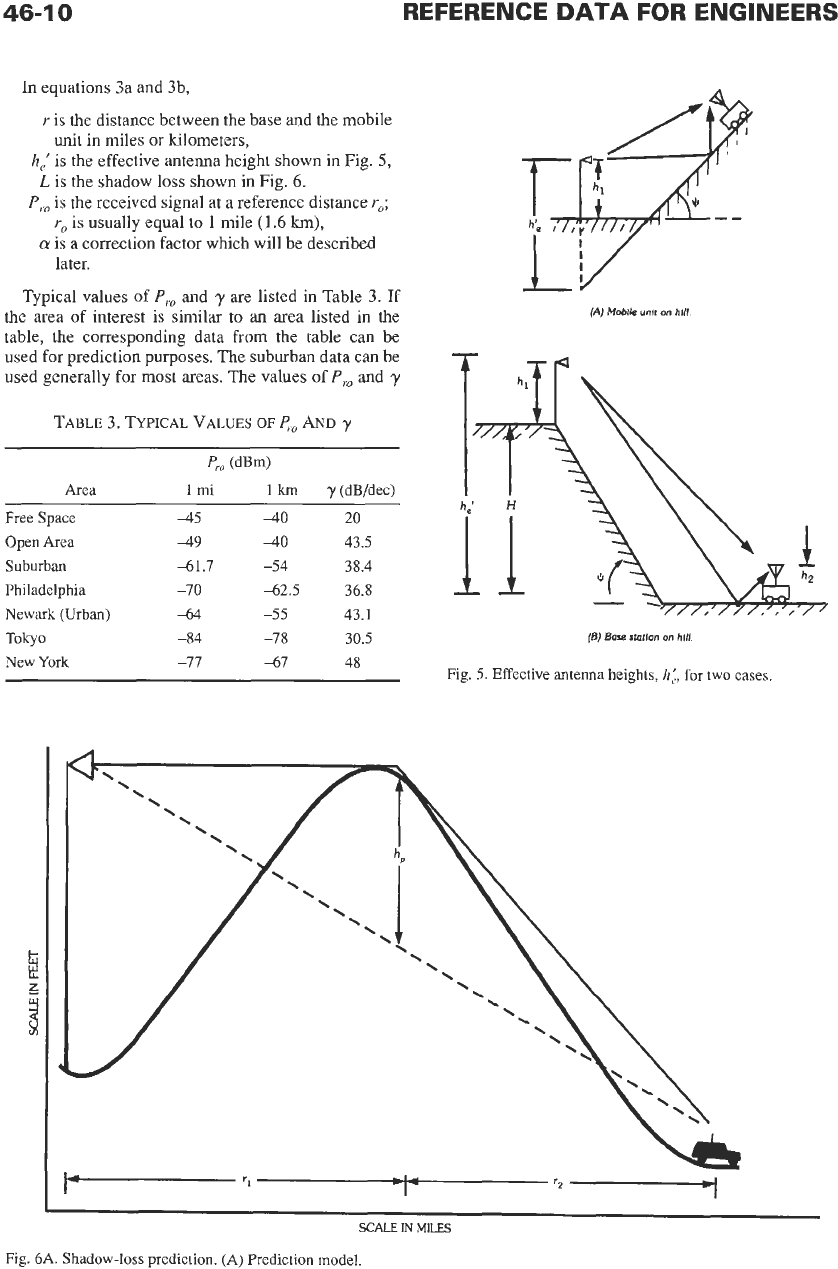
46-1
0
REFERENCE
DATA
FOR ENGINEERS
In
equations 3a and 3b,
r
is the distance between the base and the mobile
he'
is the effective antenna height shown in Fig.
5,
P,
is the received signal at a reference distance
r,;
a
is a correction factor which will be described
unit in miles or kilometers,
f,
L
is the shadow loss shown in Fig.
6.
u,
is usually equal to
1
mile
(1.6
km),
later.
(A) Moblle
unlf
on
hlll
Typical values
of
P,,
and
y
are listed in Table 3. If
the area
of
interest is similar to an area listed in the
table, the corresponding data from the table can be
used for prediction purposes. The suburban data can be
used generally for most areas. The values
of
P,,
and
y
TABLE 3.
TYPICAL
VALUES
OF
8,
hTD
y
,r,
'
Pro
(dBm)
Area
1
mi
1
km
y(dB/dec)
Free Space
45
-40
20
Open Area
-49
-40
43.5
Suburban
41.7 -54 38.4
Philadelphia
-70 -62.5 36.8
Newark
(Urban)
44 -5 5 43.1
Tokyo
-84 -78 30.5
(6)
Base
stnflon
on
hlll
New York
-77 -67 48
Fig.
5.
Effective antenna heights,
h:,
for two cases.
i'
r1
'I'
'2
-1
SCALE
IN
MILES
Fig.
6A.
Shadow-loss prediction. (A) Prediction model.
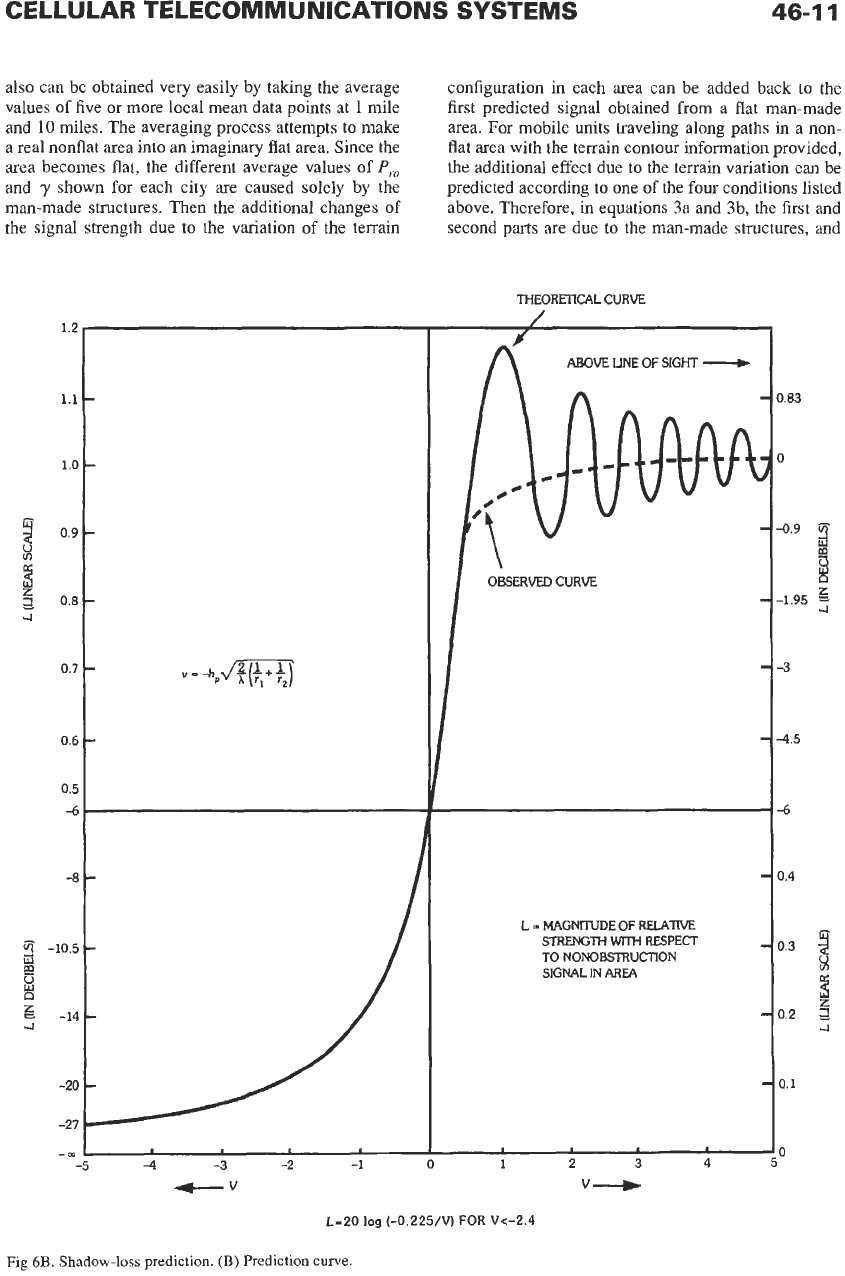
CELLULAR TELECOMMUNICATIONS SYSTEMS
46-1
I
also can be obtained very easily by taking the average
values
of
five or more local mean data points at
1
mile
and
10
miles. The averaging process attempts
to
make
a real nonflat area into an imaginary flat area. Since the
area becomes flat, the different average values of
Pro
and
y
shown for each city are caused solely by the
man-made structures. Then the additional changes of
the signal strength due to the variation
of
the terrain
configuration in each area can be added back to the
first predicted signal obtained from a flat man-made
area. For mobile units traveling along paths in a non-
flat area with the terrain contour information provided,
the additional effect due to the terrain variation can be
predicted according to one
of
the four conditions listed
above. Therefore, in equations 3a and 3b, the first and
second parts are due to the man-made structures, and
THEORETICAL CURVE
ABOVE
WE
OF
SIGHT
L
=
MAGNITUDE
OF
RELATIW
STRENGTH
WITH
RESPECT
TO
NONOBSTRUCTION
SIGNAL IN
AREA
1
2
3
4
v-
3.83
0
-0.9
3
#
m
-1.95
L.1
-3
4.5
-6
3.4
3.3
$
3
0.2
5
x
-1
0.1
0
L-20
log
(-0.22WV)
FOR
Vc-2.4
Fig
6B.
Shadow-loss prediction.
(B)
Prediction curve.
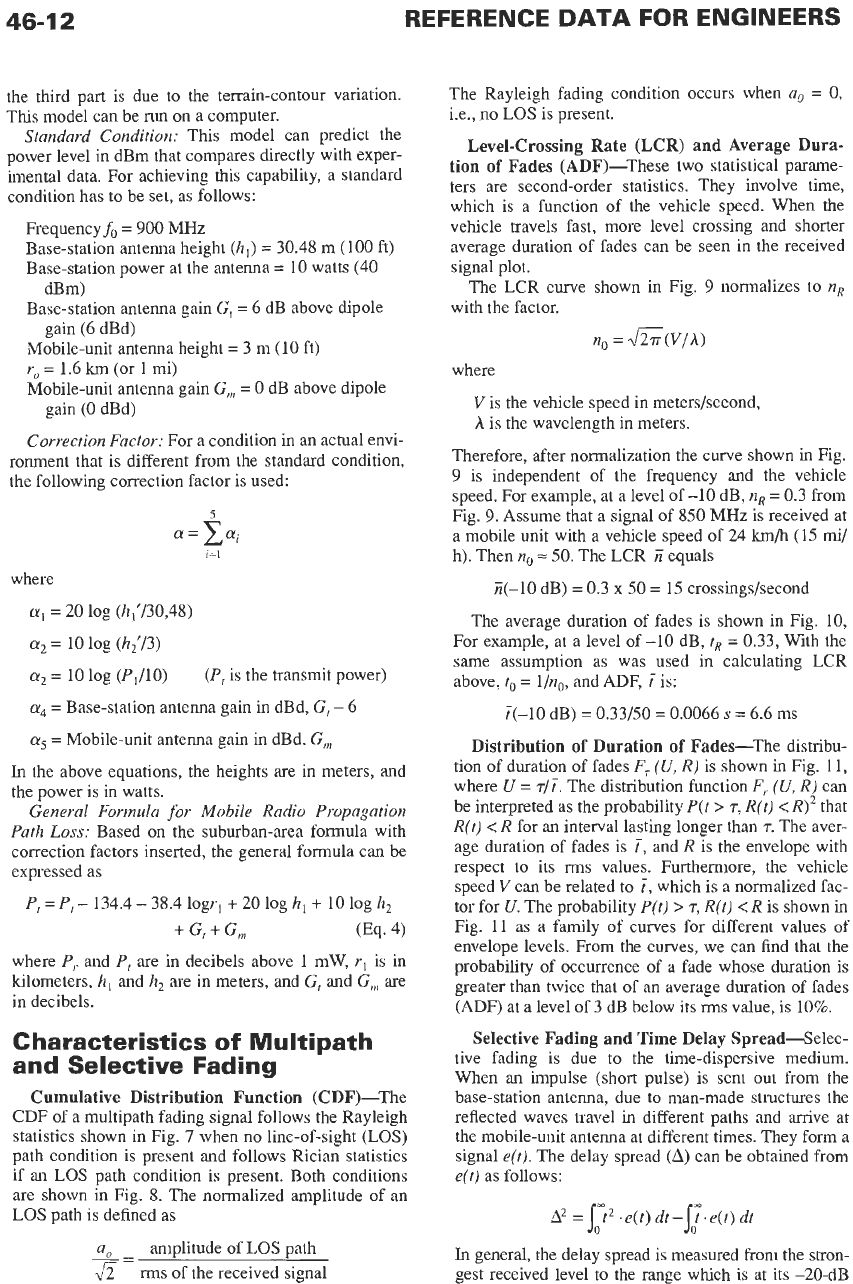
46-1
2
REFERENCE
DATA
FOR ENGINEERS
the third part is due to the terrain-contour variation.
This model can be
run
on
a computer.
Standard
Condition:
This model can predict
the
power level in dBm that compares directly with exper-
imental data. For achieving this capability, a standard
condition has to be set, as follows:
Frequencyf,
=
900 MHz
Base-station antenna height
(h,)
=
30.48 m (100
ft)
Base-station power at the antenna
=
10
watts (40
Base-station antenna gain G,
=
6 dB above dipole
Mobile-unit antenna height
=
3 m
(10
ft)
r,
=
1.6
km
(or
1
mi)
Mobile-unit antenna gain G,
=
0
dB above dipole
Correction Factor: For a condition in an actual envi-
ronment that is different from the standard condition,
the following correction factor is used:
gain (6 dBd)
gain (0 dBd)
5
a=&
i=l
where
a,
=
20 log (h,'/30,48)
or,
=
10
log (h,'/3)
a2
=
10
log
(P,/lO)
a4
=
Base-station antenna gain in dBd, G,
-
6
a5
=
Mobile-unit antenna gain in dBd, G,
(P,
is the transmit power)
In
the above equations, the heights are in meters, and
the power is in watts.
General Formula
for
Mobile Radio Propagation
Path
Loss:
Based
on
the suburban-area formula with
correction factors inserted, the general formula can be
expressed as
P,
=
P,
-
134.4
-
38.4 logr,
+
20 log
h,
+
10 log
h,
+G,+G, (Eq. 4)
where P,. and P,
are
in decibels above
1
mW,
r1
is in
kilometers,
h,
and
h,
are in meters, and G, and G,
are
in
decibels.
Characteristics
of
Mu
Iti
pat
h
and
§elective Fading
Cumulative Distribution Function (CDF)-The
CDF of a multipath fading signal follows the Rayleigh
statistics shown in Fig.
7
when no line-of-sight (LOS)
path condition is present and follows Rician statistics
if an LOS path condition is present. Both conditions
are shown in Fig.
8.
The normalized amplitude of an
LOS
path is defined as
a"
-
amplitude of
LOS
path
&
rms of the received signal
--
The Rayleigh fading condition occurs when a.
=
0,
i.e., no
LOS
is present.
Level-Crossing Rate (LCR) and Average Dura-
tion
of
Fades (ADF)-These two statistical parame-
ters are second-order statistics. They involve time,
which is a function of the vehicle speed. When the
vehicle travels fast, more level crossing and shorter
average duration of fades can be seen in the received
signal plot.
The LCR curve shown in Fig.
9
normalizes to
nR
with the factor.
no
=
&(v/A)
where
Vis the vehicle speed in meters/second,
h
is the wavelength in meters.
Therefore, after normalization the curve shown
in
Fig.
9 is independent of the frequency and the vehicle
speed. For example, at a level of
-10
dB,
nR
=
0.3 from
Fig. 9. Assume that a signal of
850
MHz is received at
a mobile unit with a vehicle speed of 24
km/h
(15
mi/
h). Then
no
=
50. The LCR
E
equals
E(-10
dB)
=
0.3
x
50
=
15 crossings/second
The average duration of fades is shown in Fig. 10,
For example, at a level of -10 dB,
tR
=
0.33, With the
same assumption as was used in calculating LCR
above, to
=
l/no, and
ADF,
f
is:
t(-10 dB)
=
0.33/50
=
0.0066
s
=
6.6 ms
Distribution
of
Duration
of
Fades-The distribu-
tion of duration of fades
F,
(U,
R) is shown
in
Fig. 11,
where
U
=
r/t.
The distribution function F,.
(U,
R) can
be interpreted as the probability P(t
>
7,
R(t)
<
R)' that
R(t)
<
R for an interval lasting longer than
7.
The aver-
age duration of fades is
t,
and R is the envelope with
respect to its
rms
values. Furthermore, the vehicle
speed
V
can be related to
t,
which is a normalized fac-
tor for
U.
The probability P(t)
>
r,
R(t)
i
R is shown in
Fig.
11
as a family of curves for different values of
envelope levels. From the curves, we can find that the
probability of occurrence of a fade whose duration is
greater than twice that of an average duration
of
fades
(ADF)
at a level
of
3
dF3
below its
rms
value,
is
10%.
Selective Fading and Time Delay SpreadSelec-
tive fading
is
due to the time-dispersive medium.
When an impulse (short pulse) is sent out from the
base-station antenna, due to man-made structures the
reflected waves travel in different paths and arrive at
the mobile-unit antenna at different times. They form a
signal e(t). The delay spread
(A)
can be obtained from
e(t) as follows:
In
general, the delay spread is measured from the stron-
gest received level to the range which is at its -20-dB
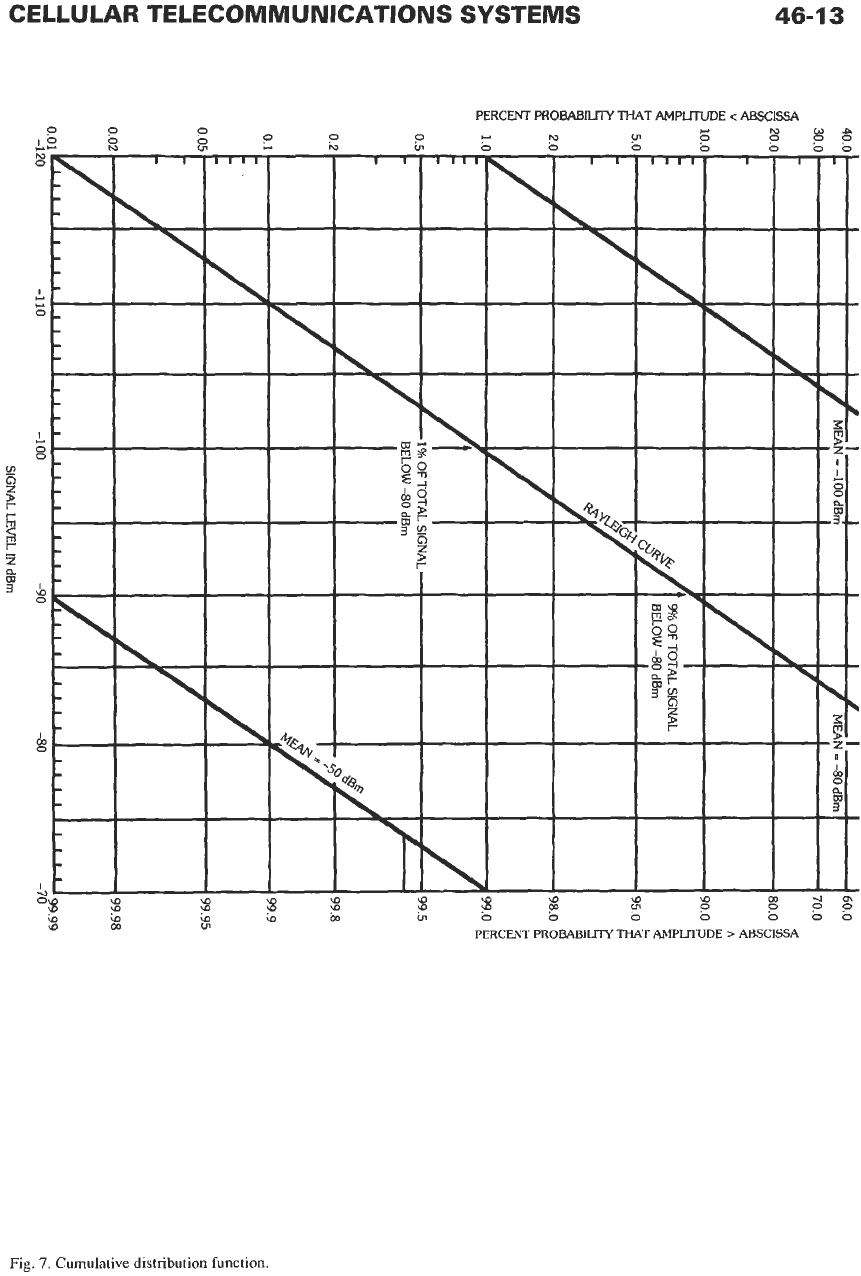
CELLULAR TELECOMMUNICATIONS SYSTEMS
46-1
3
PERCENT
PRO&ABMTY
THAT
AMPLITUDE
<
ABSCISSA
Fig.
7.
Cumulative distribution function.
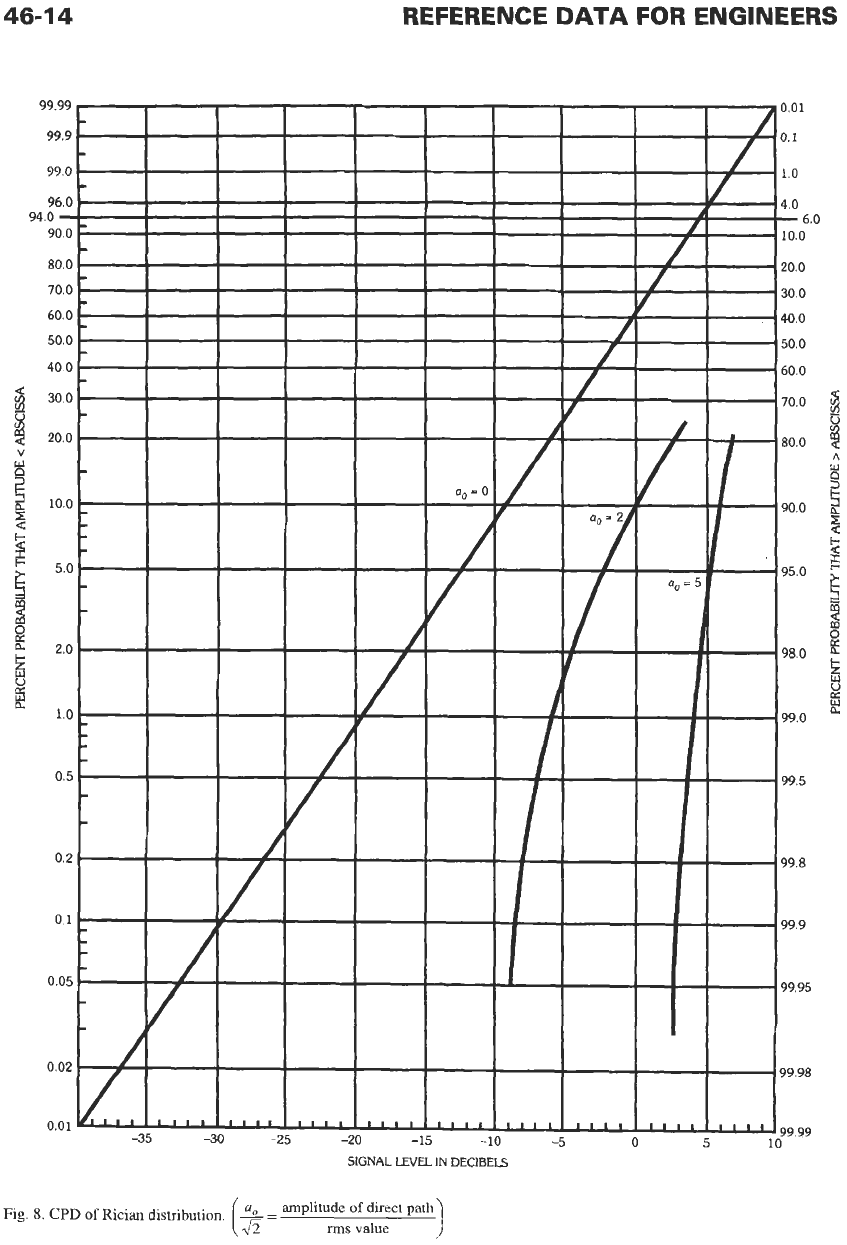
46-1
4
REFERENCE
DATA
FOR ENGINEERS
SIGNAL
LEVU.
IN
DEClBELS
amplitude
of
direct path
rms
value
Fig. 8.
CPD
of
Rician distribution.
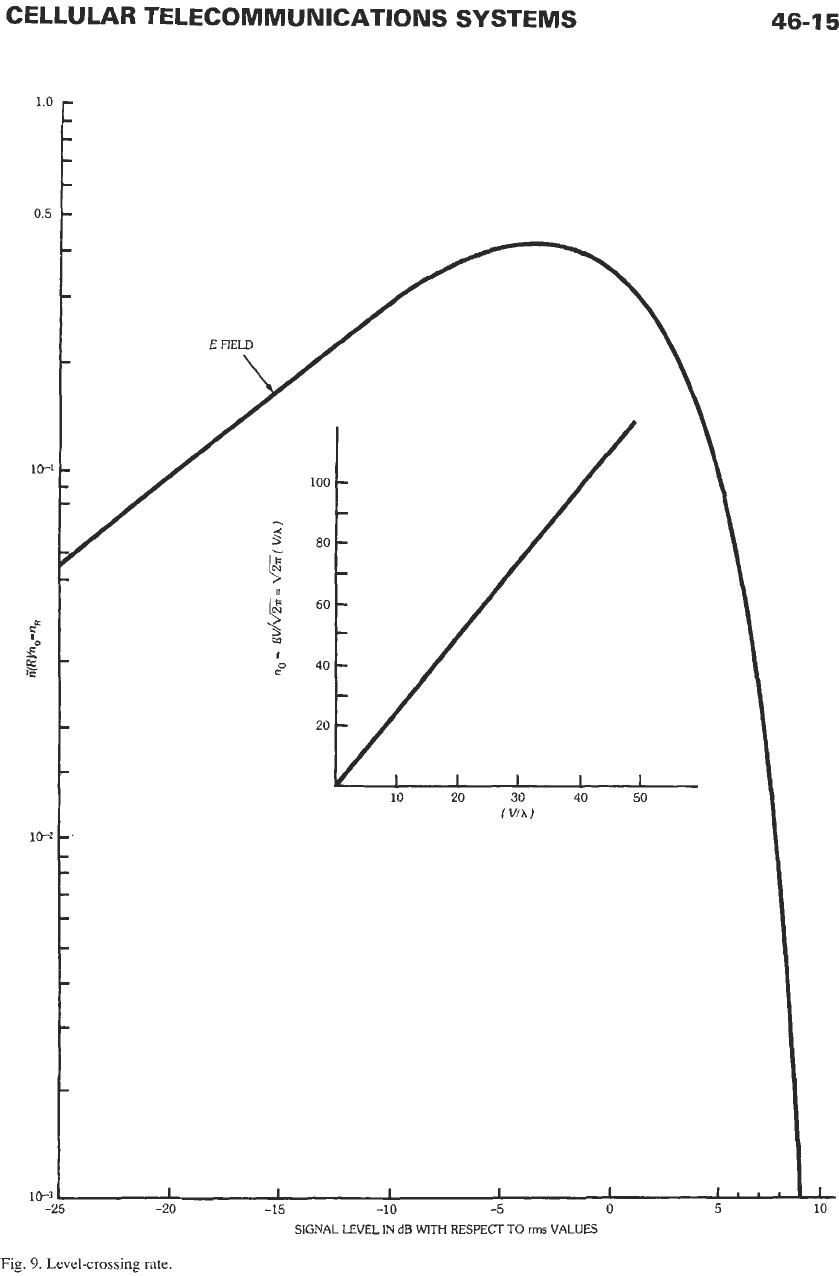
CELLULAR TELECOMMUNICATIONS SYSTEMS
1.0
0.5
10-1
100
c
46-1
5
SIGNAL LEVEL
IN
dB
WITH
RESPECT
TO
rrns
VALUES
Fig.
9.
Level-crossing
rate.
